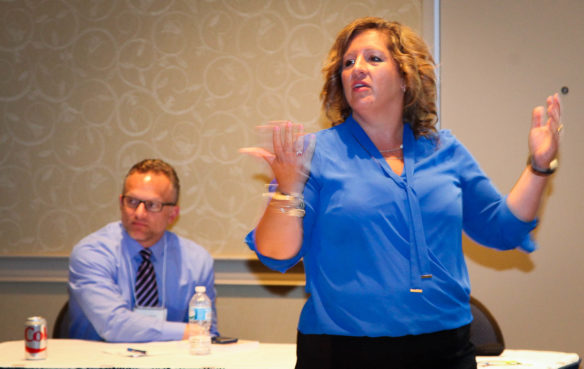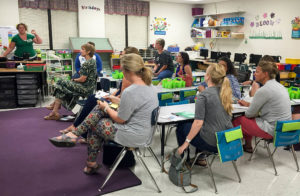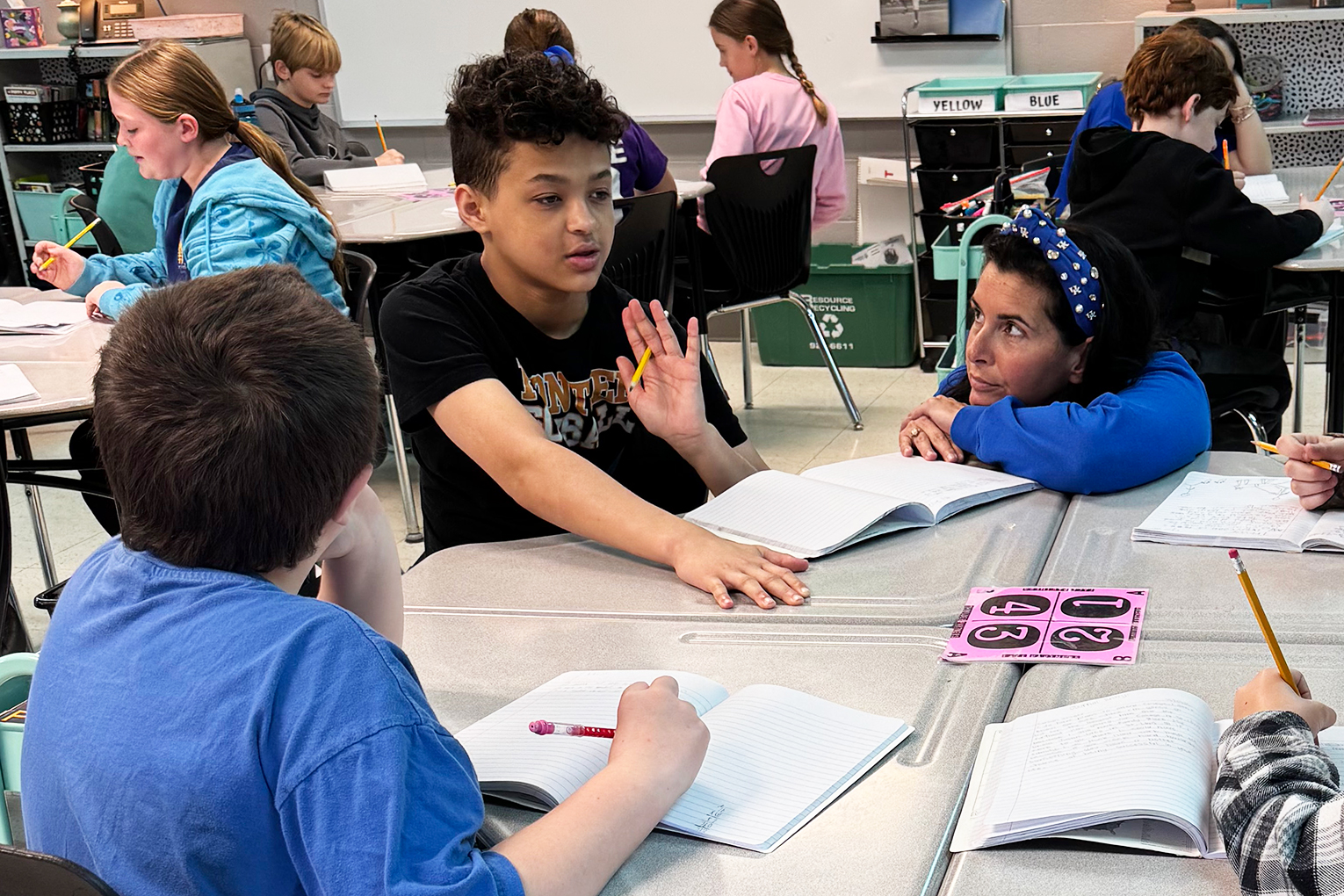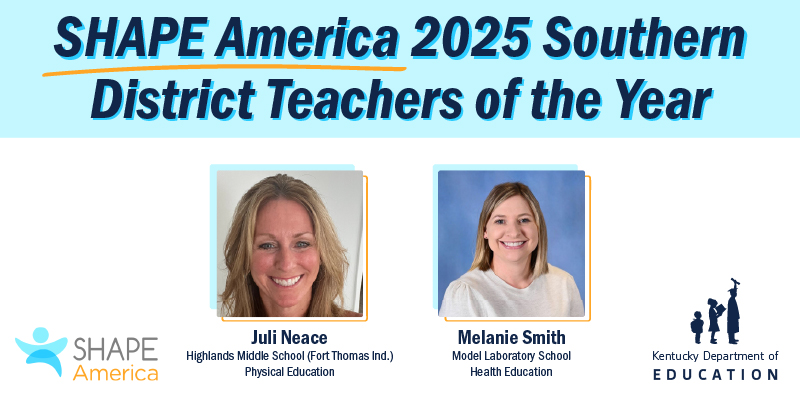
Amy Razor, executive director of the Northern Kentucky Cooperative for Educational Services, explains how the co-op created regional professional learning communities during the Continuous Improvement Summit in Lexington. Boone County Assistant Superintendent Jim Detwiler, back, who has helped with the PLC effort, also spoke at the session.
Photo by Brenna R. Kelly, Sept. 21, 2016
By Brenna R. Kelly
Brenna.kelly@education.ky.gov
What if you could only shop at stores inside a defined area? And only eat at restaurants inside that area?
“What would the quality be?” said Amy Razor, executive director of the Northern Kentucky Cooperative for Educational Services (NKCES). “Yet in education, we’re comfortable with saying Boone County is going to be Boone County and Erlanger is going to be Erlanger.”
In order to break down those walls, NKCES is bringing teachers in its 17 school districts together in hopes of improving student achievement across northern Kentucky.
“We believe that can we become stronger together than we are apart,” Razor said. “That’s a large part of our mission.”
Last year, the co-op formed 10 professional learning communities (PLCs) focusing on everything from middle school math to new teachers to physical education. The initiative recently won a Best Practice award from the Kentucky Department of Education at the 2016 Continuous Improvement Summit in Lexington.
“The regional PLCs demonstrate districts working together to have purposeful communication and to create opportunities for collaboration among teachers and leaders in northern Kentucky,” said Kelly Foster, associate commissioner of KDE’s Office of Continuous Improvement and Support.
Professional learning communities, in which teachers meet in small groups to share expertise and improve their teaching skills, have become ubiquitous in Kentucky’s public schools and districts.
“We wanted to take that a step further and use that same concept regionally,” Razor said. The co-op’s districts include both some of the highest- and lowest-performing districts in the state and some of the largest and the smallest Kentucky school districts.
In some districts there may be one art teacher, one physical education teacher or one middle school math teacher. That makes it hard for districts to provide relevant professional learning for those teachers.
“There aren’t a lot of art opportunities, especially if you’re the only one in the building,” said Buffy Houchens, one of three visual arts teachers in Walton-Verona Schools. “It’s difficult for us to find relevant, meaningful, practical professional development, so that’s what we wanted to do with the PLCs.”
Houchens now leads a group of about 12 art and music teachers who meet once a month to share ideas and hear from experts in the field.

Physical education, art and music teachers held a day-long unconference this summer as part of the Northern Kentucky Cooperative for Educational Services’ regional PLC.
Submitted photo by Northern Kentucky Cooperative for Educational Services
“I think it’s a huge benefit because you get to talk to other people in your field and you can bounce ideas off each other,” she said. “You can get practical and useful ideas and use those right away in your classroom.”
This past summer, the group worked with the physical education regional PLC to offer a joint art and P.E. day-long professional learning with Jamie Sparks, KDE’s Coordinated School Health project director.
Angela Hedenberg, the physical education PLC leader, said the teachers in her group are eager to exchange ideas.
“Basically I’m asking the other teachers to share any ideas that have worked for them in their classes, lesson plans, classroom strategies, any of the newest and greatest technology that they are using,” said Hedenberg, who teaches at Northern Elementary (Pendleton County).
The teachers can also use the gym at NKCES to try out games or hold demonstrations. At an upcoming meeting, a KDE strategic priorities in school health consultant is planning to go over the changes to the Program Review.
A few of PLCs groups got off to a rocky start, with teachers being cautious about what to share, said Michelle Augsback, an NKCES instructional coach who serves as liaison to the regional PLCs.
“It was like crickets. Nobody wanted to talk,” she said. “It was very hard, the trust just wasn’t there at first. But then they started to trust each other, to talk to each other.”
Now in the second year of the PLCs, the groups are getting more comfortable with each other, Augsback said.
“They are starting to email each other and ask for support from each other and see the benefit of coming together,” she said.
In addition to learning from each other, teachers can request resources from the co-op and even take field trips to visit other districts. The so-called “Problem of Practice” tours allow teachers to see strategies being used in the classroom, Augsback said.
“We want it to be organic and driven by their needs versus us telling them what they need,” she said.
The PLC meetings use a framework the co-op developed, combining the Thinking Strategies from Public Education & Business Coalition and professional learning guidance from Learning Forward. Using the framework allows for all the PLCs to have a common language and for that language to spread to all 96 schools in the co-op, Razor said.
“We want to this to be different than just another meeting, because lots of regions, if not all the co-operatives, have like groups getting together; that’s not a new idea,” Razor said. “But I think for northern Kentucky, what’s happening is we are using a very specific framework so that it isn’t just a meeting, but a true PLC.”
Ultimately, the goal is to collect data to measure the impact of the PLCs on student achievement in the 60,000-plus student co-op, Augsback said.
The idea is to identify one common data source in each PLC, then use it to track student growth. The PLCs will analyze the data using a five-step process that includes organization, graphing, observing, developing hypothesis of practice and then making connections.
As the work continues, Razor said she expects the PLCs will grow and evolve, but maintain the focus on improving instruction across the region.
“We see a lot of power in this,” Razor said. “The point of this work, the bigger picture beyond what is happening individually, is to unite our districts under the mission of focusing on all kids so that northern Kentucky will be a great place to learn and grow and raise a family.”
MORE INFO …
Amy Razor Amy.Razor@nkces.org
Michelle Augsback michele.augsback@nkces.org
Buffy Houchens Buffy.Houchens@wv.kyschools.us
Angela Hedenberg Angela.hedenberg@pendleton.kyschools.us




Leave A Comment